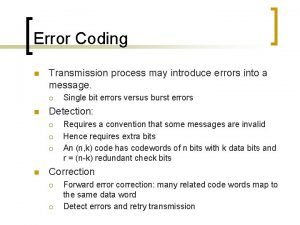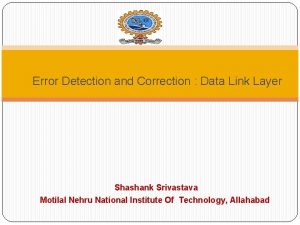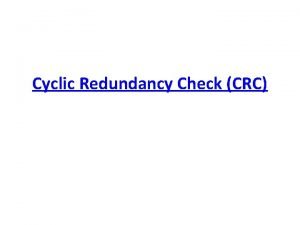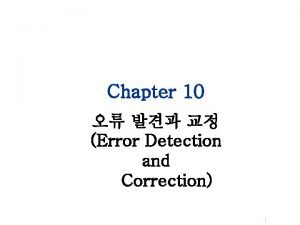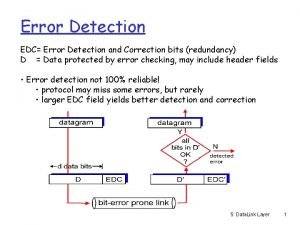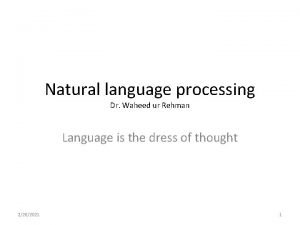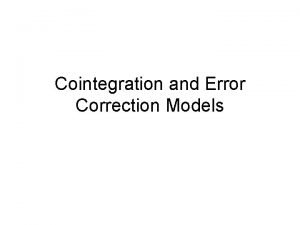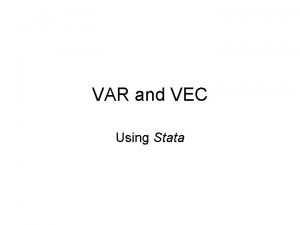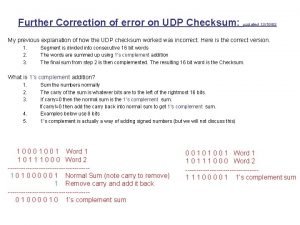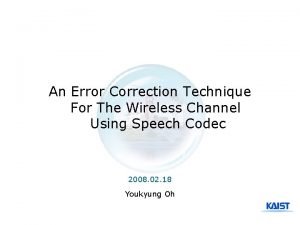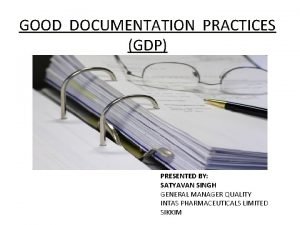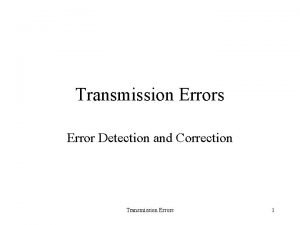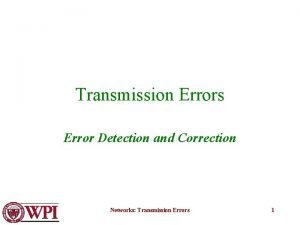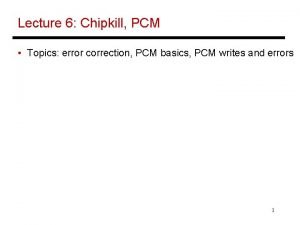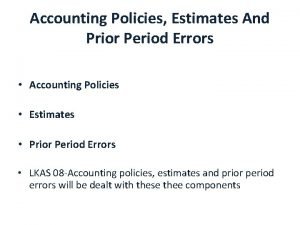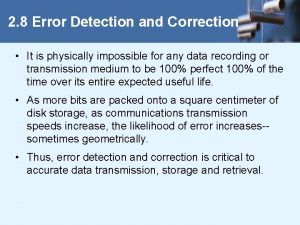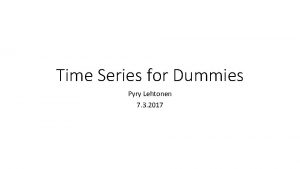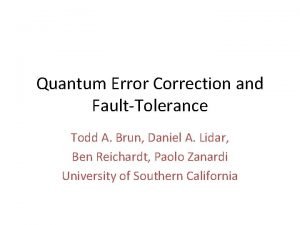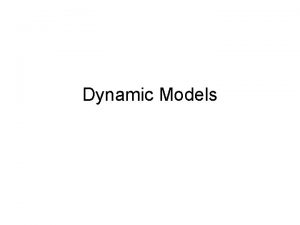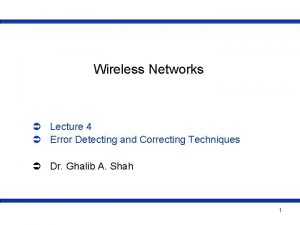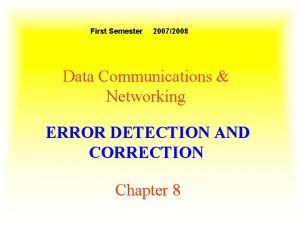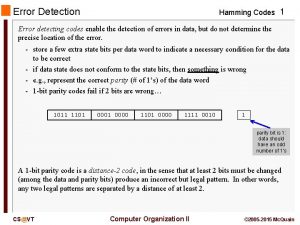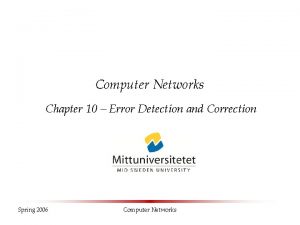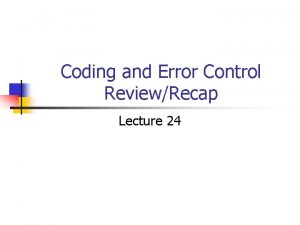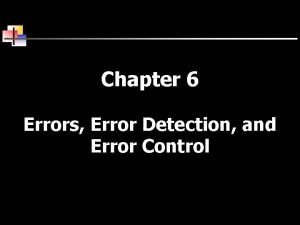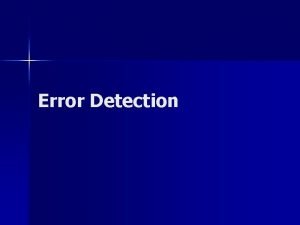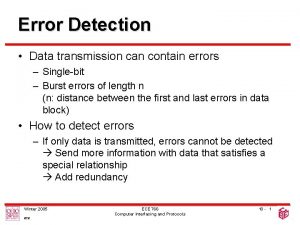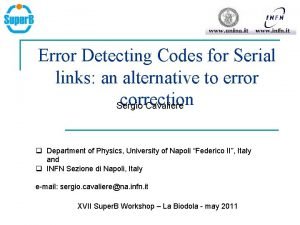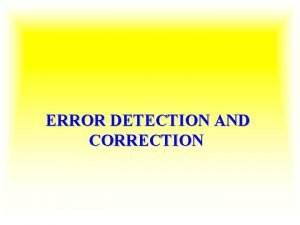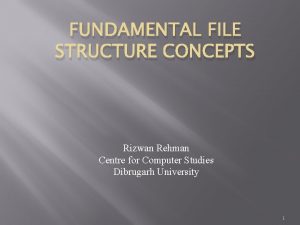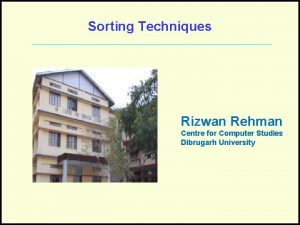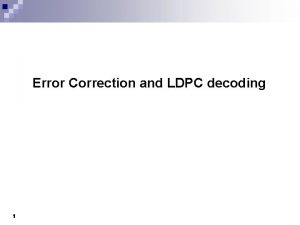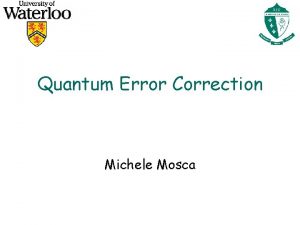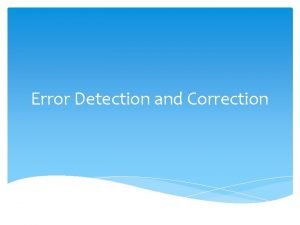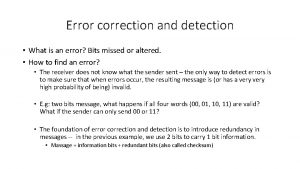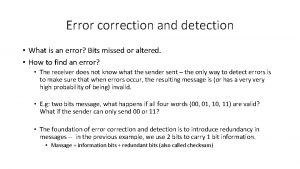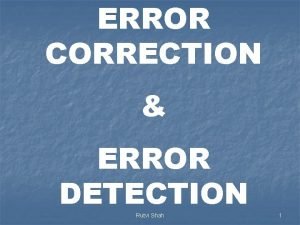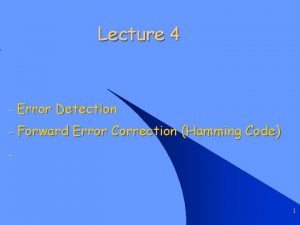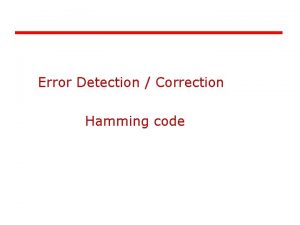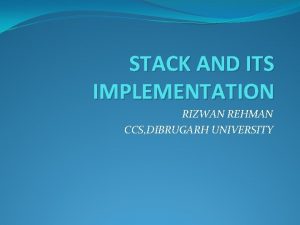Error Detection and Correction Rizwan Rehman Centre for













































- Slides: 45

Error Detection and Correction Rizwan Rehman Centre for Computer Studies Dibrugarh University

Note The Hamming distance between two words is the number of differences between corresponding bits.

Example Let us find the Hamming distance between two pairs of words. 1. The Hamming distance d(000, 011) is 2 because 2. The Hamming distance d(10101, 11110) is 3 because

Note The minimum Hamming distance is the smallest Hamming distance between all possible pairs in a set of words.

Example The dmin in this case is 2.

Example The dmin in this case is 3.

Note To guarantee the detection of up to s errors in all cases, the minimum Hamming distance in a block code must be dmin = s + 1.

Figure Geometric concept for finding dmin in error detection

Figure Geometric concept for finding dmin in error correction

Note To guarantee correction of up to t errors in all cases, the minimum Hamming distance in a block code must be dmin = 2 t + 1.

Example A code scheme has a Hamming distance dmin = 4. What is the error detection and correction capability of this scheme? Solution This code guarantees the detection of up to three errors (s = 3), but it can correct up to one error. In other words, if this code is used for error correction, part of its capability is wasted. Error correction codes need to have an odd minimum distance (3, 5, 7, . . . ).

Table Hamming code C(7, 4) - n=7, k = 4

Figure The structure of the encoder and decoder for a Hamming code

Table Logical decision made by the correction logic analyzer

Example Let us trace the path of three datawords from the sender to the destination: 1. The dataword 0100 becomes the codeword 0100011. The codeword 0100011 is received. The syndrome is 000, the final dataword is 0100. 2. The dataword 0111 becomes the codeword 0111001. The received codeword is: 0011001. The syndrome is 011. After flipping b 2 (changing the 1 to 0), the final dataword is 0111. 3. The dataword 1101 becomes the codeword 1101000. The syndrome is 101. After flipping b 0, we get 0000, the wrong dataword. This shows that our code cannot correct two errors.

Example 10. 14 We need a dataword of at least 7 bits. Calculate values of k and n that satisfy this requirement. Solution We need to make k = n − m greater than or equal to 7, or 2 m − 1 − m ≥ 7. 1. If we set m = 3, the result is n = 23 − 1=7 and k = 7 − 3, or 4, which is < 7. 2. If we set m = 4, then n = 24 − 1 = 15 and k = 15 − 4 = 11, which satisfies the condition k>7. So the code is C(15, 11)

Burst Errors n n n Burst errors are very common, in particular in wireless environments where a fade will affect a group of bits in transit. The length of the burst is dependent on the duration of the fade. One way to counter burst errors, is to break up a transmission into shorter words and create a block (one word per row), then have a parity check per word. The words are then sent column by column. When a burst error occurs, it will affect 1 bit in several words as the transmission is read back into the block format and each word is checked individually.

Figure Burst error correction using Hamming code

CYCLIC CODES Cyclic codes are special linear block codes with one extra property. In a cyclic code, if a codeword is cyclically shifted (rotated), the result is another codeword. Topics discussed in this section: Cyclic Redundancy Check

Table A CRC code with C(7, 4)

Figure CRC encoder and decoder

Figure Division in CRC encoder

Figure Division in the CRC decoder for two cases

Figure Hardwired design of the divisor in CRC

Figure Simulation of division in CRC encoder

Figure The CRC encoder design using shift registers

Figure General design of encoder and decoder of a CRC code

Using Polynomials n n We can use a polynomial to represent a binary word. Each bit from right to left is mapped onto a power term. The rightmost bit represents the “ 0” power term. The bit next to it the “ 1” power term, etc. If the bit is of value zero, the power term is deleted from the expression.

Figure polynomial to represent a binary word

Figure CRC division using polynomials

Note The divisor in a cyclic code is normally called the generator polynomial or simply the generator.

Note In a cyclic code, If s(x) ≠ 0, one or more bits is corrupted. If s(x) = 0, either a. No bit is corrupted. or b. Some bits are corrupted, but the decoder failed to detect them.

Note In a cyclic code, those e(x) errors that are divisible by g(x) are not caught. Received codeword (c(x) + e(x))/g(x) = c(x)/g(x) + e(x)/gx The first part is by definition divisible the second part will determine the error. If “ 0” conclusion -> no error occurred. Note: that could mean that an error went undetected.

Note If the generator has more than one term and the coefficient of x 0 is 1, all single errors can be caught.

Example Which of the following g(x) values guarantees that a single-bit error is caught? For each case, what is the error that cannot be caught? a. x + 1 b. x 3 c. 1 Solution a. No xi can be divisible by x + 1. Any single-bit error can be caught. b. If i is equal to or greater than 3, xi is divisible by g(x). All single-bit errors in positions 1 to 3 are caught. c. All values of i make xi divisible by g(x). No single-bit error can be caught. This g(x) is useless.

Figure Representation of two isolated single-bit errors using polynomials

Note If a generator cannot divide xt + 1 (t between 0 and n – 1), then all isolated double errors can be detected.

Example Find the status of the following generators related to two isolated, single-bit errors. a. x + 1 b. x 4 + 1 c. x 7 + x 6 + 1 d. x 15 + x 14 + 1 Solution a. This is a very poor choice for a generator. Any two errors next to each other cannot be detected. b. This generator cannot detect two errors that are four positions apart. c. This is a good choice for this purpose. d. This polynomial cannot divide xt + 1 if t is less than 32, 768. A codeword with two isolated errors up to 32, 768 bits apart can be detected by this generator.

Note A generator that contains a factor of x + 1 can detect all odd-numbered errors.

Note ❏ All burst errors with L ≤ r will be detected. ❏ All burst errors with L = r + 1 will be detected with probability 1 – (1/2)r– 1. ❏ All burst errors with L > r + 1 will be detected with probability 1 – (1/2)r.

Example Find the suitability of the following generators in relation to burst errors of different lengths. a. x 6 + 1 b. x 18 + x 7 + x + 1 c. x 32 + x 23 + x 7 + 1 Solution a. This generator can detect all burst errors with a length less than or equal to 6 bits; 3 out of 100 burst errors with length 7 will slip by; 16 out of 1000 burst errors of length 8 or more will slip by.

Example (continued) b. This generator can detect all burst errors with a length less than or equal to 18 bits; 8 out of 1 million burst errors with length 19 will slip by; 4 out of 1 million burst errors of length 20 or more will slip by. c. This generator can detect all burst errors with a length less than or equal to 32 bits; 5 out of 10 billion burst errors with length 33 will slip by; 3 out of 10 billion burst errors of length 34 or more will slip by.

Note A good polynomial generator needs to have the following characteristics: 1. It should have at least two terms. 2. The coefficient of the term x 0 should be 1. 3. It should not divide xt + 1, for t between 2 and n − 1. 4. It should have the factor x + 1.

Table Standard polynomials

Thank You
 Difference between error detection and error correction
Difference between error detection and error correction Checksum in computer networks with example
Checksum in computer networks with example Error detection and correction in data link layer
Error detection and correction in data link layer Crc binary division
Crc binary division Error detection and correction
Error detection and correction E dc error
E dc error What is crc in computer network
What is crc in computer network Error detection and correction in computer networks
Error detection and correction in computer networks Dr raja rizwan
Dr raja rizwan Raja 105
Raja 105 Anita roddick leadership style
Anita roddick leadership style Bait rizwan
Bait rizwan Dr rizwan dentist
Dr rizwan dentist Fasih ur rehman
Fasih ur rehman Dr waheed rehman
Dr waheed rehman Tahira rehman
Tahira rehman Abdul rehman chughtai paintings
Abdul rehman chughtai paintings Ben rehman
Ben rehman Error correction
Error correction Stata vec
Stata vec Error correction code adalah
Error correction code adalah Udp error correction
Udp error correction Wifi error correction
Wifi error correction 4-step error correction procedure pecs
4-step error correction procedure pecs Typical retention period of batch related records
Typical retention period of batch related records Correction of error
Correction of error Transmission errors
Transmission errors Pcm
Pcm Good documentation practices in clinical research
Good documentation practices in clinical research Correction of prior period error
Correction of prior period error Correction of error
Correction of error Pyry lehtonen
Pyry lehtonen Error correction code
Error correction code Quantum error correction
Quantum error correction Partial adjustment model
Partial adjustment model Two dimensional parity check
Two dimensional parity check Error detection methods
Error detection methods Hamming code error detection
Hamming code error detection Error detection adalah
Error detection adalah Computer
Computer Error detection methods
Error detection methods Error detection methods
Error detection methods N 10101001
N 10101001 Six errors of trial balance
Six errors of trial balance Error in data transmission
Error in data transmission Crc error detection
Crc error detection
